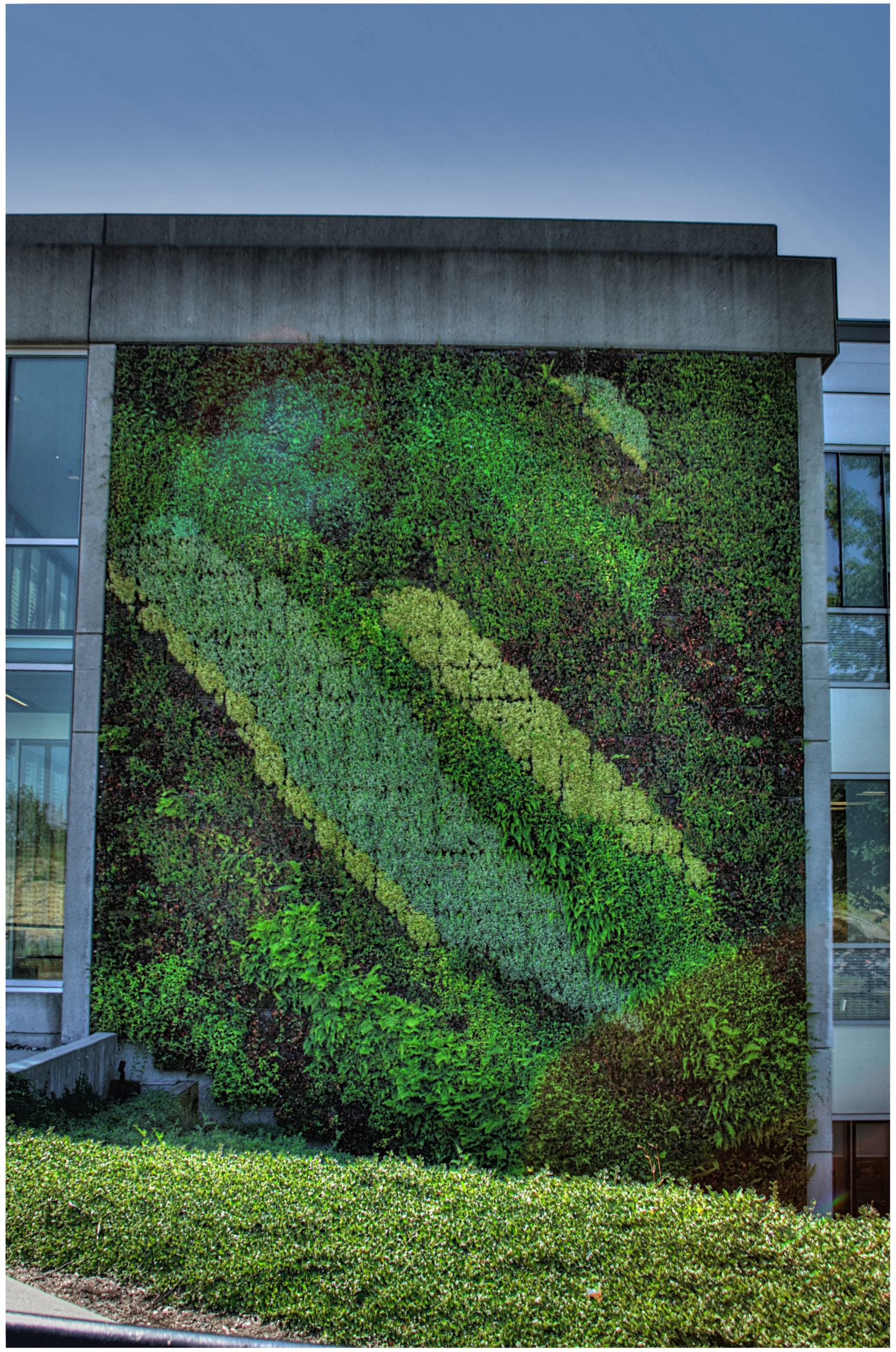A green living wall is a piece of biophilic design. According to built-environment research, “[b]iophilic design is a holistic practice utilizing nature-based systems, engineering principles, and design cues to support improved health, well-being, and performance as measured through personal biometrics, self-rated mood, and work quality” (Africa et al., 2019, p. 1). A biophilic design element in a public building, such as a green living wall, mitigates both the harmful disruption of ecosystems and the impact of climate change on human beings (Africa et al., 2019; Wijesooriya & Brambilla, 2021). A green living wall enhances the overall environmental conditions, detoxifies the air, and increases biodiversity. It also contributes to people’s mental and physical health, allowing them to reconnect to natural rhythms while enjoying the aesthetic beauty of nature. Another benefit is that environments with biophilic design elements can improve the intellectual and commercial productivity of the people who live and work in them.
A green living wall can also be a pedagogical opportunity. It can be used to introduce language learners to the Anthropocene. There is sufficient scope for discussing environmental topics within language classes. Environmental themes are commonly addressed and assessed in syllabi at level B1 (CEFR) across several modern foreign languages. The environment is also an internationally significant subject. It is a priority among the institutions and countries interested in the UN’s Sustainable Development Goals as well as the policies that are being implemented to meet those targets by 2030.
However, addressing the Anthropocene as a theme in a language class can be challenging. Language classes tend to focus on language acquisition/development and production. Students may develop appreciated and sought-after skills by discussing, evaluating, debating, and building an appropriate lexicon for the subject, but an understanding of the value of the Anthropocene itself can remain in the background. That is because, in this instance, the ‘theme’ is instrumental to reaching linguistic proficiency. The contradictions inherent in current attempts to address and mitigate the environmental impact of humans and contemporary life can fade into the background or may be difficult to express. For instance, well-being practices are increasingly implemented in public and private spaces, yet the capitalistic drive to extract value is still at work. Everyday practices are informed by extractivist logics, which operate by segmenting natural organic wholes into discrete quantities (Acosta, 2013; Freire, 1968).
A living wall embodies the contradictions that are in play: it is meant to reconnect the human to nature (ecological entanglement), but it is also meant to increase productivity (extractivism). Language learners can engage with an array of nuances regarding such contradictions. This raises an overarching question:
A living wall is a piece of life that meshes the natural and the human. It is also an objectification of representational/abstract space, a discursive and symbolic practice of biophilic design/architecture, and an implemented public policy (Lefebvre, 1991).
Pedagogically a green living wall can serve as the prompt for a set of multisensorial and embodied activities, such as discussions or performances, that question how learners experience the Anthropocene as a way of being. The prompt urges language learners to consider their experiences of and entanglement with nature and capitalism. Furthermore, the object can prompt an interrogation of language pedagogy itself:
Questions
- How can the tensions embedded in the object itself be captured pedagogically so that the Anthropocene is understood and, importantly, experienced as a way of being (thinking, speaking, and doing)?
- To what extent is a green living wall really lived, breathed, or attuned to as a bundle of “inter-actions” and environmental entanglements (Barad, 2017; Lefebvre, 2004)?
- How can we ascertain whether a practice is biophilic or necrophilic (Freire, 1968)?
- How can a language pedagogy engender ways of learning that are non-extractivist and mindful of ecological entanglements?
Readings
Acosta, A. (2013). Extractivism and neoextractivism: Two sides of the same curse. Beyond development: Alternative visions from Latin America, 1, 61–86.
Africa, J., Heerwagen, J., Loftness, V., & Ryan Balagtas, C. (2019). Biophilic design and climate change: Performance parameters for health. Frontiers in Built Environment, 5, 28.
Barad, K. (2007). Meeting the universe halfway: Quantum physics and the entanglement of matter and meaning. Durham, NC/London: Duke University Press.
Freire, P. (2017/1968) Pedagogy of the oppressed (Trans. M. Bergman Ramos). London: Penguin Books.
Lefebvre, H. (1991/1974). The production of space (Trans. D. Nicolson-Smith). Oxford: Blackwell.
Lefebvre, H. (2004/1992). Rhythmanalysis: Space, time, and everyday life (Trans. S. Elden & G. Moore). London: Continuum.
Puig de la Bellacasa, M. (2017). Matters of care: Speculative ethics in more than human worlds. Minneapolis, MN: University of Minnesota Press.
Rayner, A. D. (2004). Inclusionality and the role of place, space, and dynamic boundaries in evolutionary processes. Philosophica, 73, 51–70.
Rayner, A. D. (2011). Space cannot be cut: Why self-identity naturally includes neighbourhood. Integrative Psychological and Behavioral Science, 45(2), 161–184.Wijesooriya, N., & Brambilla, A. (2021). Bridging biophilic design and environmentally sustainable design: A critical review. Journal of Cleaner Production, 283, 124591.
Author: Anna Costantino
